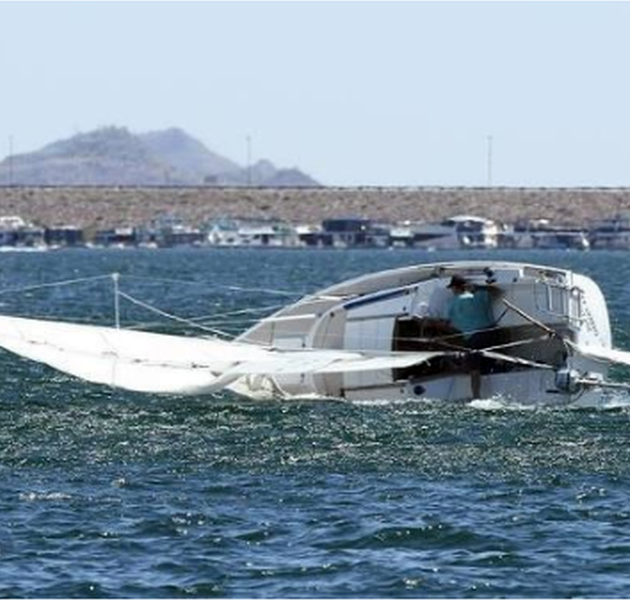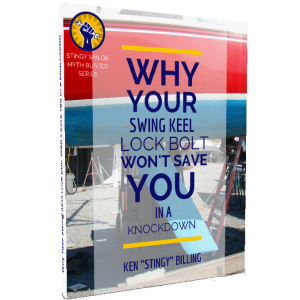If you spend much time around other C-22 owners or online C-22 forums, you’re bound to hear the following myth over and over. It goes something like this…
The Catalina 22 uses a locking bolt to keep the keel down in case of a knock-down.
It’s been debated on and off over the years from various perspectives but the myth hasn’t been silenced yet because it still rears its ugly head with alarming frequency. I won’t claim that this report will bury the myth for good, but for the benefit of new owners or those who are still confused by the different arguments, I’ll attempt to refute them.
A knockdown is what happens when a sailboat gets pushed over 90° or more by wind and/or waves. Most modern sailboats are designed with enough ballast to right themselves in a knockdown and many veteran racers have experienced them first-hand. If the sailboat gets pushed over even further to the point where it cannot right itself, it is considered capsized. This report is about how the C-22 swing keel lock bolt can do little to help the sailboat self-right in a knockdown and, in fact, contribute to a capsize.

I call it a myth because that claim is not made by Catalina Yachts in the C-22 literature and because the design of the so-called “lock” bolt is such that it could not fulfill that claim under most circumstances. I will admit that I’m not a marine accident expert or a licensed engineer, but this myth doesn’t need either one to debunk it, just some common sense and high school level math skills.
This report takes that myth head-on to prove it’s nonsense. I’ll give you some background on the myth and then we’ll test the myth against three criteria:
- Intent – What was the original intention of the design of the lock bolt?
- Design – Is it physically possible for the lock bolt to hold the keel stationary in a knockdown? In an inversion?
- Evidence – Is there credible evidence that the lock bolt has, in fact, held keels stationary in real-world accidents?
The preceding is the introduction to my 18-page ebook Why Your Swing Keel Lock Bolt Won’t Save You in a Knockdown. Written with the help of a licensed professional engineer, it’s the result of weeks of research and mathematical analysis at the level of The error in a popular DIY DVD that will slow down your C-22. If you like that blog post, I think you’ll like this ebook as well.
 After reading this report, you will know:
After reading this report, you will know:
- The truth about the lock bolt, what it’s for and what it’s not for.
- Whether the lock bolt can produce enough clamping force to hold your keel from accidentally retracting if your C-22 gets knocked down or turns turtle.
- What can happen with your keel if you hit an underwater object while under sail and what can happen in a knockdown.
- How to prevent expensive, potentially catastrophic hull damage from a free-swinging keel.
You can get this first installment in my Myth Busted Series absolutely free! Just click the button below and the ebook will open in your browser where you can save a copy on your device or print it.



Very interesting article. I have recently bought a C22 that did not have a keel. It fell out at the dock into 4′ of mud and was not retreived. Having recently located one and prepareing to refurbish it I am looking at doing it properly.
Thanks for this site and all your info to us $tingy sailors also.
Geoff
Do you find the info can generally transfer to any swing keel sailboat (like the Venture/Macgregor 21)?
Hi, Ed
I haven’t extensively studied other designs so I can’t advise about those but my guess would be that only a locking pin that passes completely through the keel and engages the hull on both sides or a similar design would be trustworthy in extreme conditions.
Thanks for asking,
$tingy
I can not get the link to work
Sent from Mail for Windows 10
Hello, Eddie
I’m sorry you’re having trouble downloading the file. I haven’t received any other reports of problems with it. Can you try it from a different device or browser? If you continue to have trouble, let me know and I’ll email it to you. Although, Mail for Windows 10 is notorious for not showing email attachments.
$tingy
So what is a long time in salt water? We had our 1986 C-22 in for more than a year and it was definitely hard on the keel, but we took it down to bare metal, put on a few coats of Pettit Rustloc, a couple layers of Pettit fiberglass, and then three coats of Pettit anti-fouling paint. The keel pivot and hole were fine. We decided to keep it in salt water for only two months in the summer.
Hello, John
What I meant by “long time” in the ebook is more than the sailing season, not year-round like your experience was. Some C-22 owners leave their boats in a slip indefinitely, not what it was designed for. If I lived in Florida and wanted to sail year-round, I’d consider a fixed keel sailboat. Obviously, fresh water is not nearly as bad as salt water. Your repairs and decision to limit exposure to salt water will make your keel last a very long time. Good job!
Thanks for your question,
$tingy